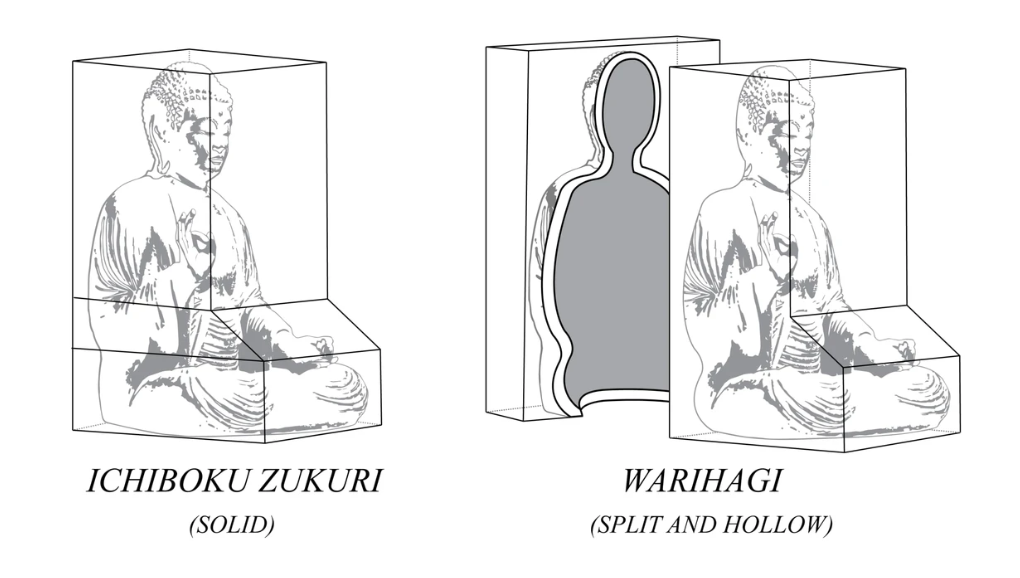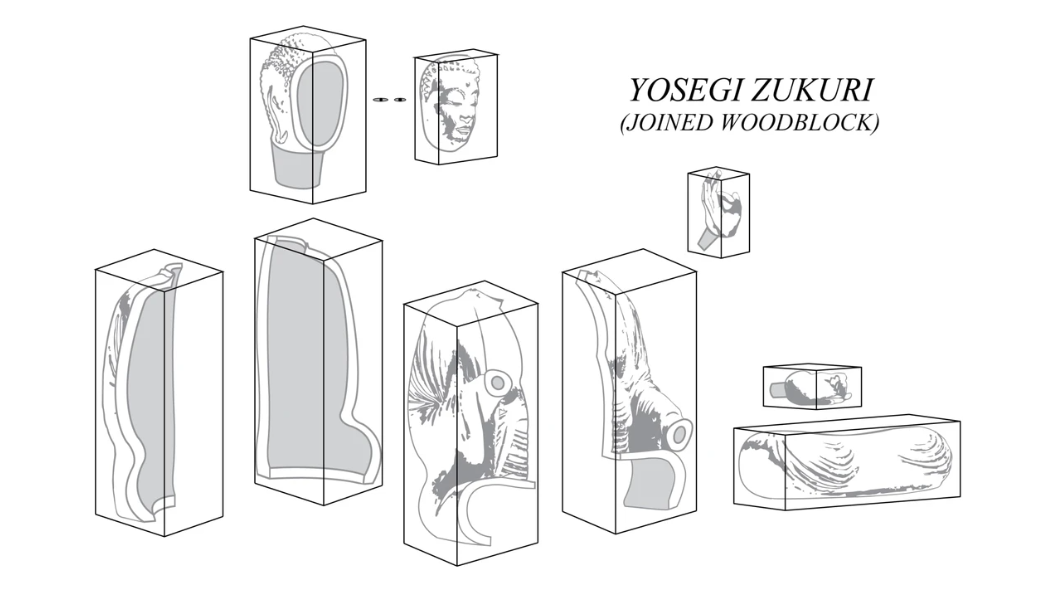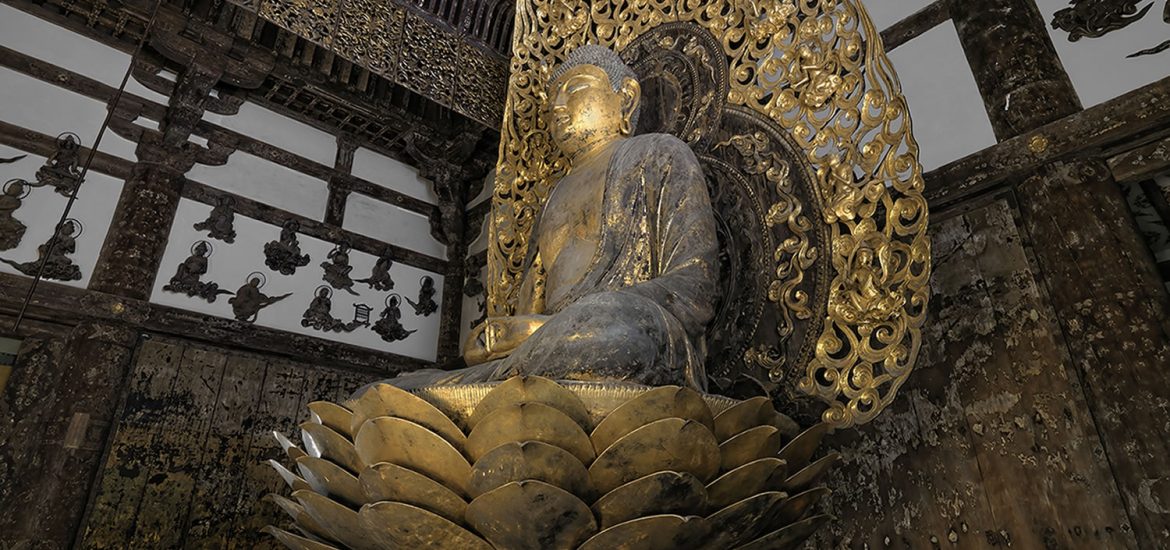In the last few posts exploring the heritage of Japanese Buddhist sculpture, we have touched upon various techniques of the people that made this discipline. For example, the early contribution of Jocho in the first decades of the 11th Century was to distinguish a localized, Japanese aesthetic distinct from earlier importations of Buddhist images from China.
Techniques would depend on what looks and moods the clients were looking for, and the shifts in tastes were made apparent with the transition of sculpture as a heavily elitist interest confined to the aristocracy (exemplified by the Fujiwara nobles) to the more robust and popular stylizations of the Kei school, as favored by the newly established Kamakura Shogunate under the Minamoto clan.
Finally, at the direction of the Shogunate, the Kei school’s master busshi, Unkei and Kaikei, put aside their rivalry and sculpted the massive kongorikishi guardians (nio) at the Great South Gate of Todai-ji – a commission like no other since perhaps the art of butsuzo was established on the islands of Japan.
With every busshi school, there proliferated. In his Butsuzōtion blog, which builds on Yujiro Seki’s coverage of various historical periods and techniques of the busshi, David Bilbrey looked at the diverse techniques of woodcarving that encompass the broadly Japanese style of woodcarving, Wayo. Broadly speaking, they encompass the general methodologies, in descending order of complexity:
- Ichiboku (solid woodblock) zukuri (carving)
- Natabori (solid woodblock “ripping”)
- Warihagi (split and hollow)
- Yosegi (joined woodblock) zukuri
In this and the next two posts, we shall explore these techniques, passed down from busshi master to apprentice, in more vivid detail.
The actual beginnings of butsuzo lie, Bilbrey argues, with perhaps an irony: artists were fundamentally dissatisfied with the rigid limitations of wood carvings as seen from the 7th century’s Asuka period, during which Buddhism first began to take root in Japan. Horyu-ji’s Guze Kannon and the Shitenno group “were sculpted from single beams of lumber, with arms held close to the sides, save for affixed hands or other small attachments. Many other sculptures were also mainly carved from large and heavy blocks of wood.” (Butsuzōtion) This single block technique is called ichiboku zukuri, when the head and torso are carved from the same piece of solid wood, but could be cumbersome in weight and suffer from uneven drying after painting. The impetus to diversify from ichiboku zukuri as well as beautify according to local tastes necessitated an innovation and creative divergence from Chinese and Korean techniques.

In the 9th Century, the problems found with ichiboku zukuri led to sculptors trying a rough hollowing process called uchiguri. Through this technique, sculptors could lighten the weight of the sculpture and allow for the wood to dry more evenly. However, since artists could not hollow out a solid wood sculpture from the front or top (for fear of ruining the head or front of the piece, this always had to be attempted on the bottom of a statue, which was mechanically problematic. The result of this conundrum gave rise to a sculptor’s technique called warihagi, which simply meant first splitting the core of the statue – usually the head and the torso – in half. This would allow a proficient busshi to remove a great deal more of the inner mass. Then the parting line would be glued or stapled back together. Hence the name: split and hollow.

Thanks to this innovation, statues became progressively bigger and more intricate, and butsuzo reached a much grander scale by the 10th and 11th centuries. Warihagi proved to be a revolutionary method that would spawn the first of the great named busshi in medieval Japan: Jocho, who did not settle for gluing two blocks of wood together, but multiple blocks. He was the advocate of the most advanced form of woodcarving: yosegi zukuri, where blocks (already split via warihagi) were cut down to their approximate respective sizes to more quickly remove unwanted material. This saved time and enhanced efficiency throughout the sculpting process. For Jocho, there was no limit to sheer scale and ambition as long as the components could be joined together.
In other words, yosegi zukuri combined the methods of hollowing with splitting to gain an advantage over both methods that had stuck to only one priority. This also meant that the statuary could be crafted by a team of sculptors, which opened the path to lucrative group projects and accelerated the rise of the busshi schools, which would otherwise only have consisted of lone individuals competing for commissions. From Jocho onwards, butsuzo proliferated in a way hitherto unseen in Japan thanks to the radical upgrade in speed, quantity, and size of statuary. The only major problem was that Japan’s ancient forests were decimated; sadly, the deforestation of old Japan can be blamed directly on religious impulses and artistic ambition.
Next time, we shall explore several key examples of this seminal style of yosegi zukuri. Another carving technique which arose in Japan’s east in the late 10th century was natabori, meaning using an unpainted, rough-cut surface. Key markers for a natabori sculpture include visible gouge or round chisel cuts still visible on the surface after the statue is complete, and detractors of the style might say that these are but indicators of unfinished statues. Bilbrey has observed that some writers prefer to classify it as part of the ichiboku zukuri family, but the aesthetic is distinct enough for these sculptures to warrant their own exploration later on.
Carving the Divine is now crowdfunding for distribution on IndieGoGo
See more
Woodcarving Techniques for Scale (Butsuzōtion)
The Vulgar Anatomy of the Kongōrikishi (Butsuzōtion)
Ripping a Style Apart (Butsuzōtion)
Related blog posts from BDG
Lives of the Busshi: Japanese Sculpture Under the Kamakura
Of Artisans and Aristos: Butsuzo Flourishing in Japan
Jocho: The maestro that started Japanese Buddhist Sculpture
The Yuji Experience: A Singular Voice for Japanese Buddhist Sculpture

